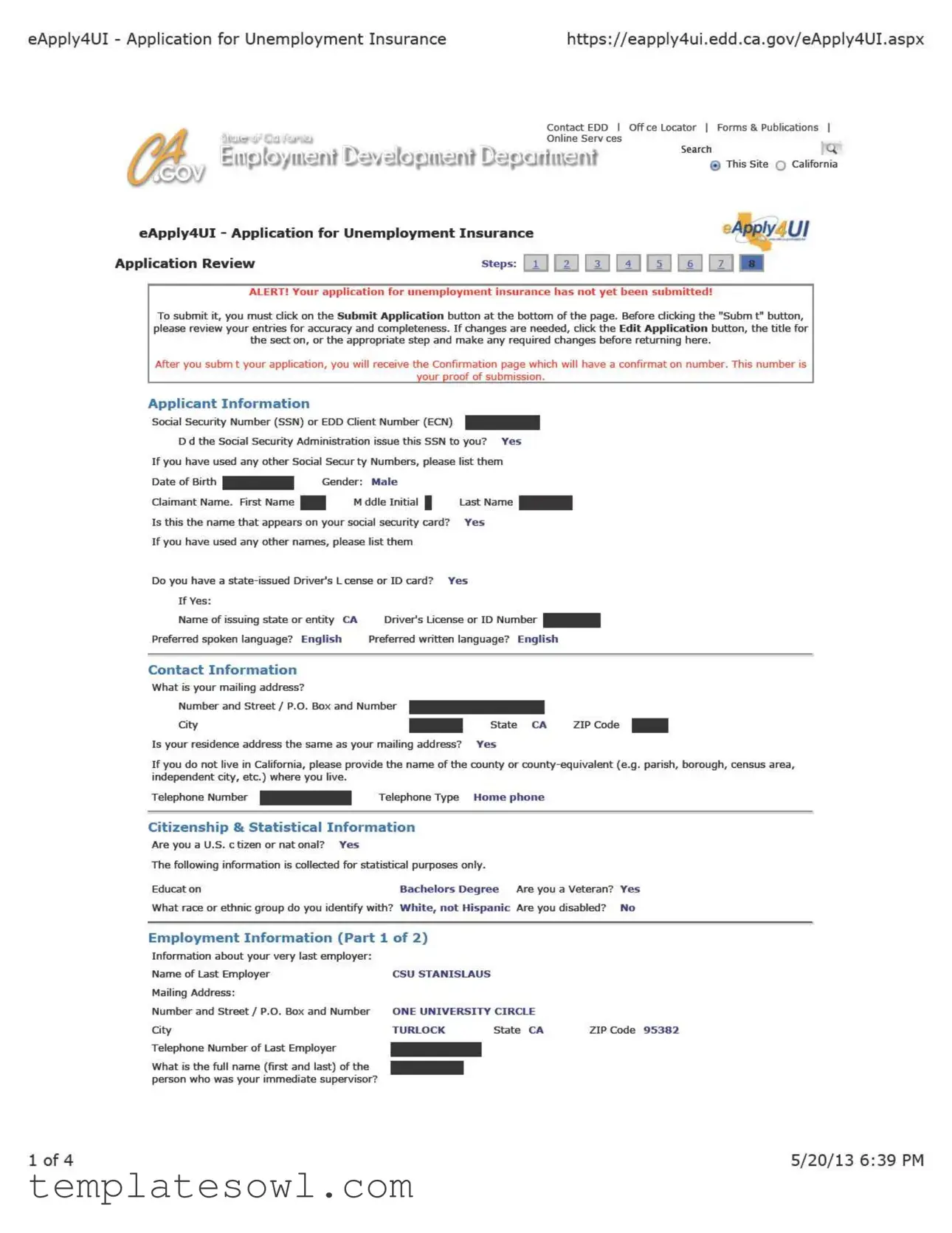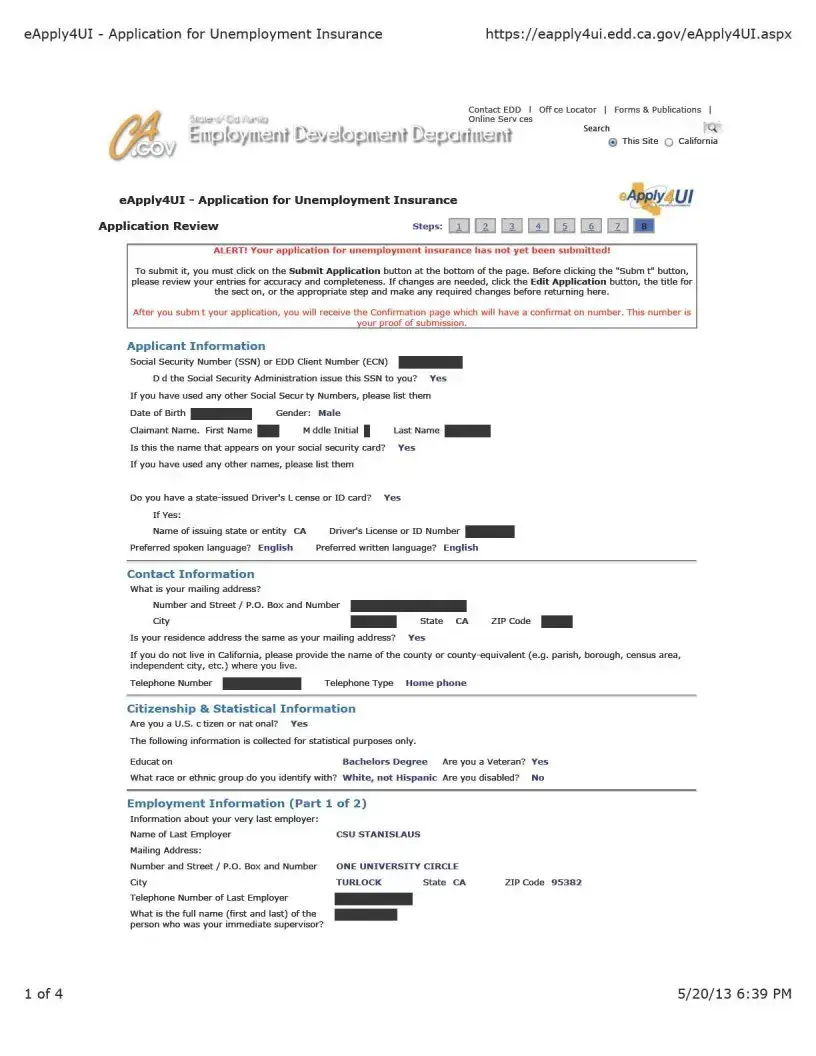Is the location or physical address of your very last employer the same as their mailing address? Yes
Last Date Worked |
05/18/2013 |
What are your gross wages for your last week of work (regular pay only)? $1,446.13
For UI purposes, a week begins on Sunday and ends the following Saturday. Whether you have been paid or not, report your total gross wages for your regular pay for the hours worked in the last week you worked, beginning w th Sunday and ending w th your last day of work as reported in question 3.
To calculate your total gross wages for your last week of work, multiply your hourly rate of pay by the total hours you worked from Sunday through the last day you worked (add piece work pay, if applicable).
Important!
If you were paid or if you will be pa d Holiday Pay, Vacation Pay, Severance Pay, In-Lieu-Of-Notice Pay, Other Pay (including, but not limited to, bonus pay, or commiss on pay), do NOT report these payments in question 4 as part of your gross wages. Report them separately in Other Payments quest on.
Reason No Longer Working: Laid Off/Lack of Work
Please provide a brief explanation (Maximum 150 characters): Part-time lecturer contract completed. No reasonable assurance of new work per EDD 1253.3(g).
If you received, or if you expect to receive, any payments from your very last employer or any other employer other than you regular salary, report the payment below.
From Date |
To Date |
(mm/dd |
(mm/dd |
Amount /yyyy) |
/yyyy) |
Holiday Pay
Vacation Pay
Severance Pay
In-Lieu-Of-Notice Pay
Other Pay
Please explain Other Pay, if any (Maximum 150 characters):
Employment Information (Part 2 of 2)
Prov de your employment history for the past 18 months, including your very last employer. If you worked for a temporary agency, a labor contractor, an agent for actors, or an employer where wages are reported under a corporate name, your wages may have been reported under that employer name. You may want to refer to your check stub(s) or W-2(s) to obtain the name of your employer.
Note: Failure to report all employers, periods of employment, and total wages may result in your benefits being delayed or denied. Provide as much accurate information as possible for each employer.
1-1. Employer Information |
|
|
|
|
|
|
|
|
|
|
|
a. Employer Name |
|
|
CSU STANISLAUS |
|
|
|
|
|
b. Mailing Address |
|
|
ONE UNIVERSITY CIRCLE |
|
c. City |
|
|
|
TURLOCK |
|
|
|
|
|
d. State |
|
|
|
CA |
|
|
|
|
|
|
|
e. ZIP Code |
|
|
|
95382 |
|
|
|
|
|
|
|
f. First day you worked for this employer |
|
01/28/2013 |
|
|
|
|
|
g. Last day you worked for this employer |
|
05/18/2013 |
|
|
|
|
|
h. D d you work full time or part time? |
|
Part Time |
|
|
|
|
|
i. How much d d you earn per hour? |
|
$94.83 |
|
|
|
|
|
|
|
j. How many hours did you work per week? |
15 |
|
|
|
|
|
|
|
|
|
|
|
|
|
|
|
|
|
|
|
|
Gross wages |
Gross wages |
Gross wages |
Gross wages |
Gross wages |
Gross wages |
|
|
earned from |
earned from |
earned from |
earned from |
earned from |
earned from |
|
|
1/1/2012 to |
4/1/2012 to |
7/1/2012 to |
10/1/2012 to |
1/1/2013 to |
4/1/2013 to |
|
|
3/30/2012 |
6/30/2012 |
9/30/2012 |
12/30/2012 |
|
3/30/2013 |
6/30/2013 |
|
|
$5,121.00 |
$6,543.00 |
$4,979.00 |
$5,690.00 |
|
$13,015.00 |
$8,677.00 |
|
|
|
|
|
|
|
|
|
|
|
|
|
|
|
|
|
|
|
|
|
|
1-2. Did you work for another employer in the last 18 months? Yes |
|
|
|
|
|
|
|
|
|
|
|
|
|
|
|
1-2. Employer Information |
|
|
|
|
|
|
|
|
|
|
a. Employer Name |
|
|
|
|
|
|
|
|
|
|
|
|
|
|
|
|
|
|
|
|
b. Mailing Address |
|
|
|
|
|
|
|
. |
|
|
c. City |
|
|
|
|
|
|
|
|
|
|
|
d. State |
|
|
|
CA |
|
|
|
|
|
|
e. ZIP Code |
|
|
|
|
|
|
|
|
|
|
|
|
|
|
|
|
|
|
|
|
|
|
f. First day you worked for this employer |
|
11/11/2011 |
|
|
|
|
g. Last day you worked for this employer |
|
5/20/2013 |
|
|
|
|
h. D d you work full time or part time? |
|
Part Time |
|
|
|
|
$0.00 |
|
|
|
$60.00 |
|
|
|
|
|
|
j. How many hours did you work per week? |
1 |
|
|
|
|
|
|
|
|
|
|
|
|
|
|
|
|
|
|
|
|



